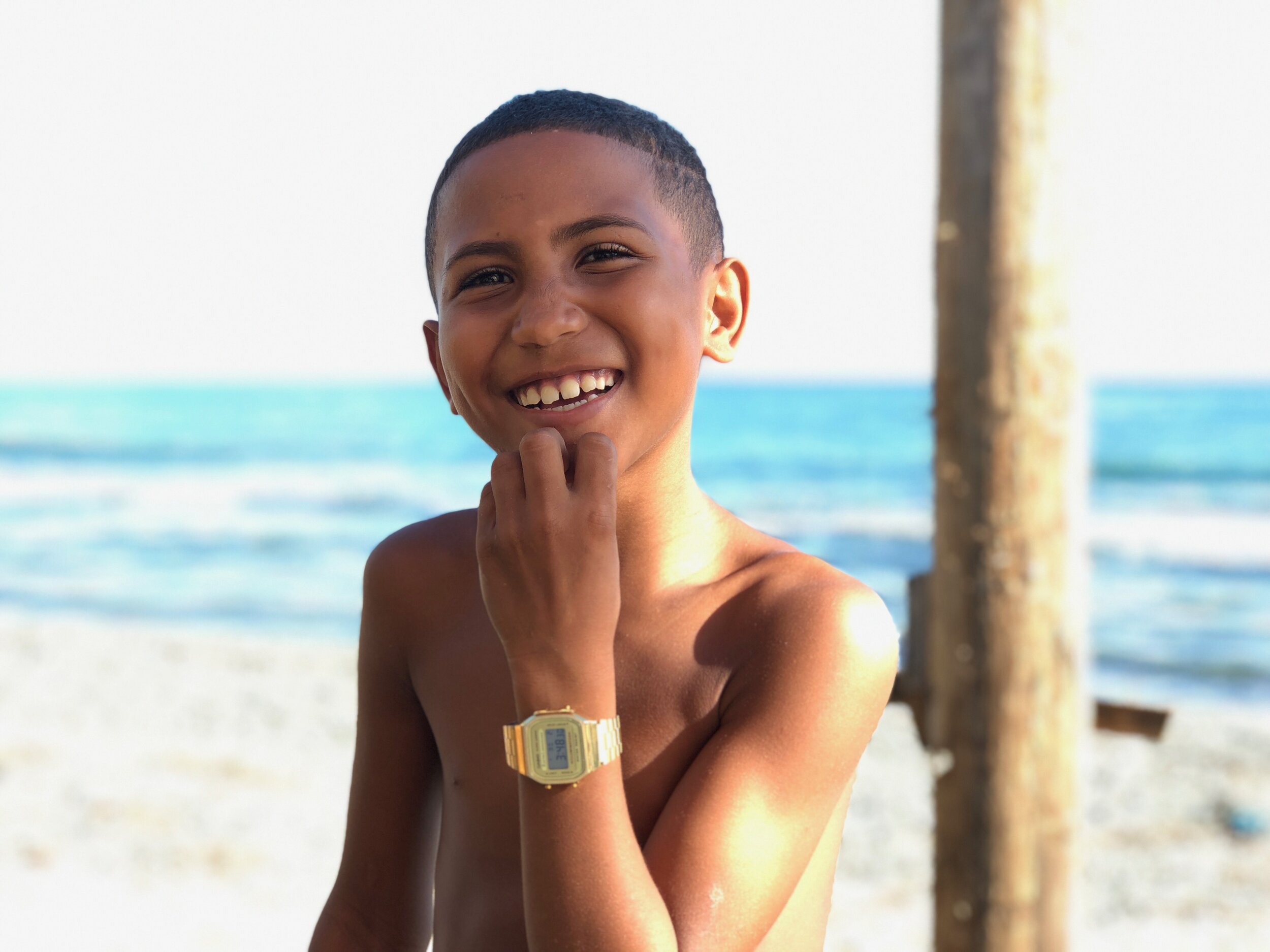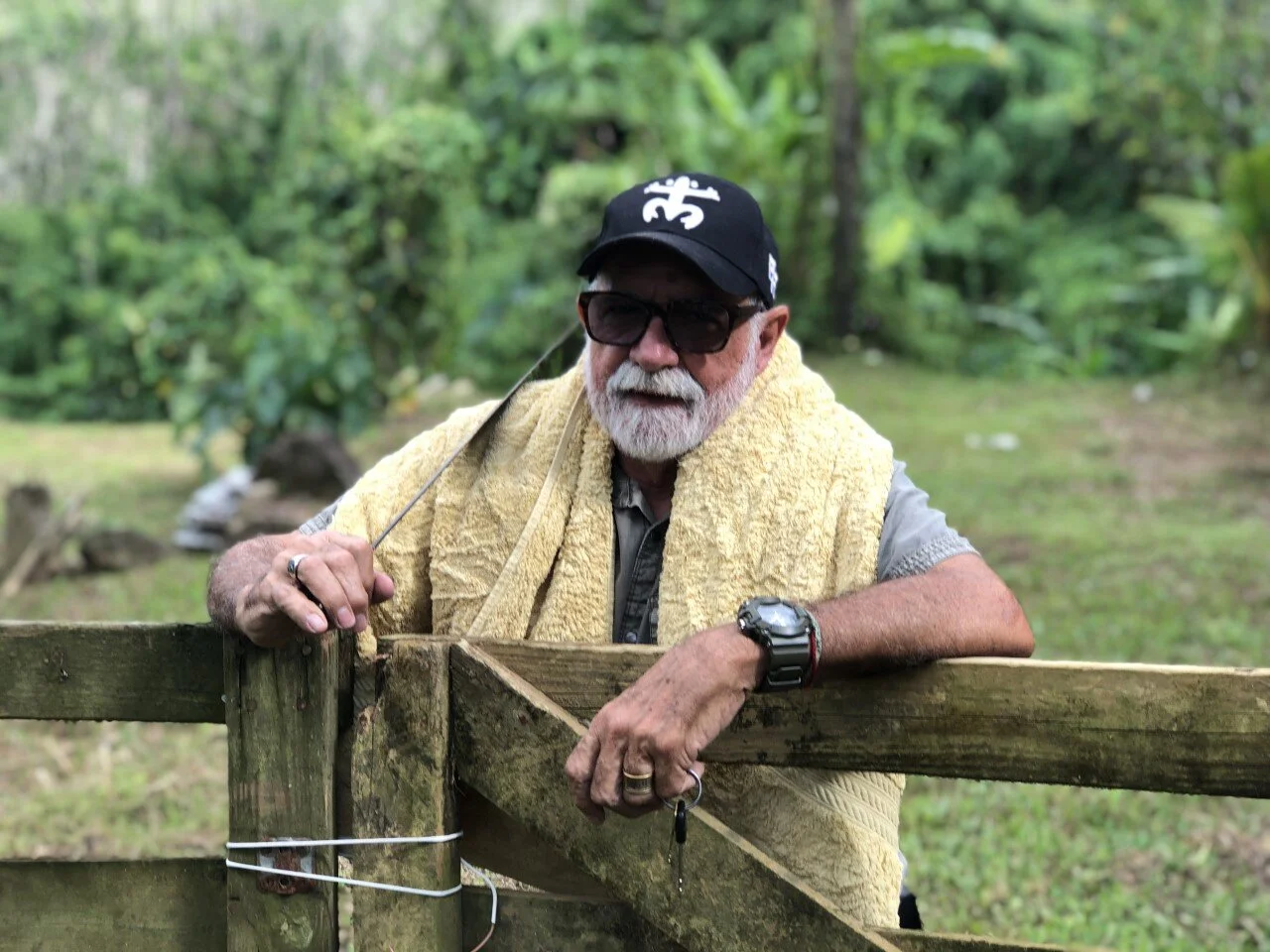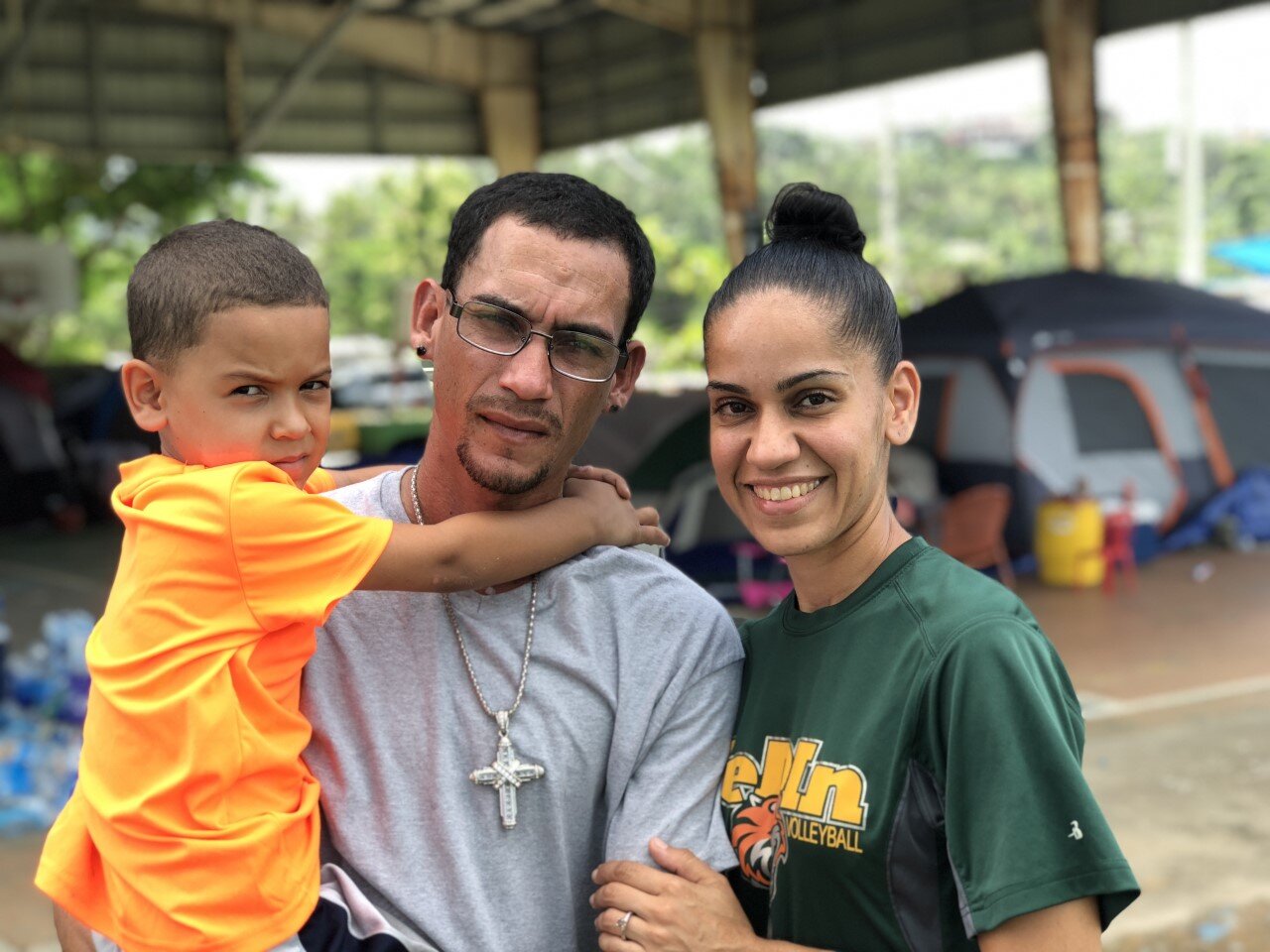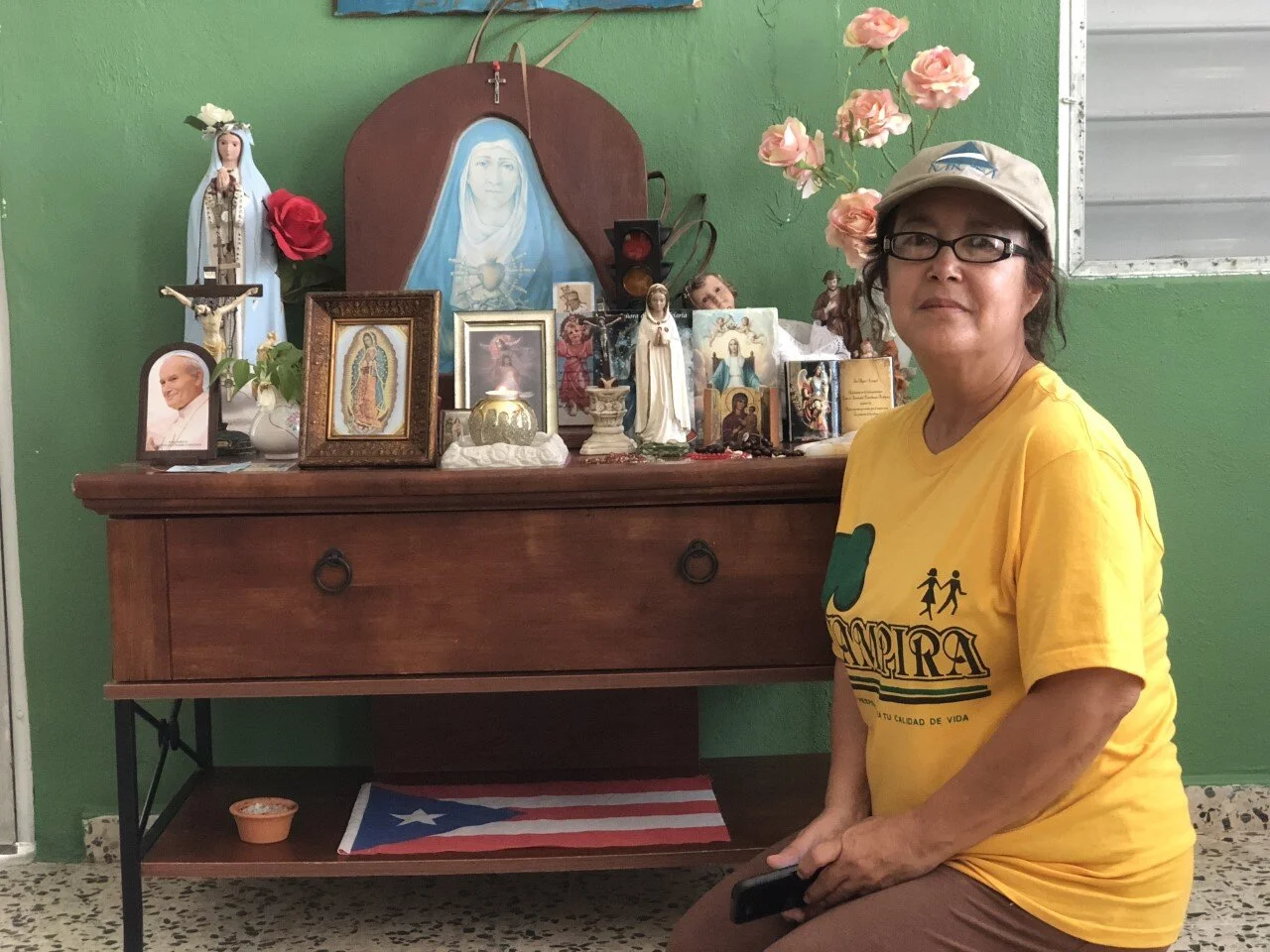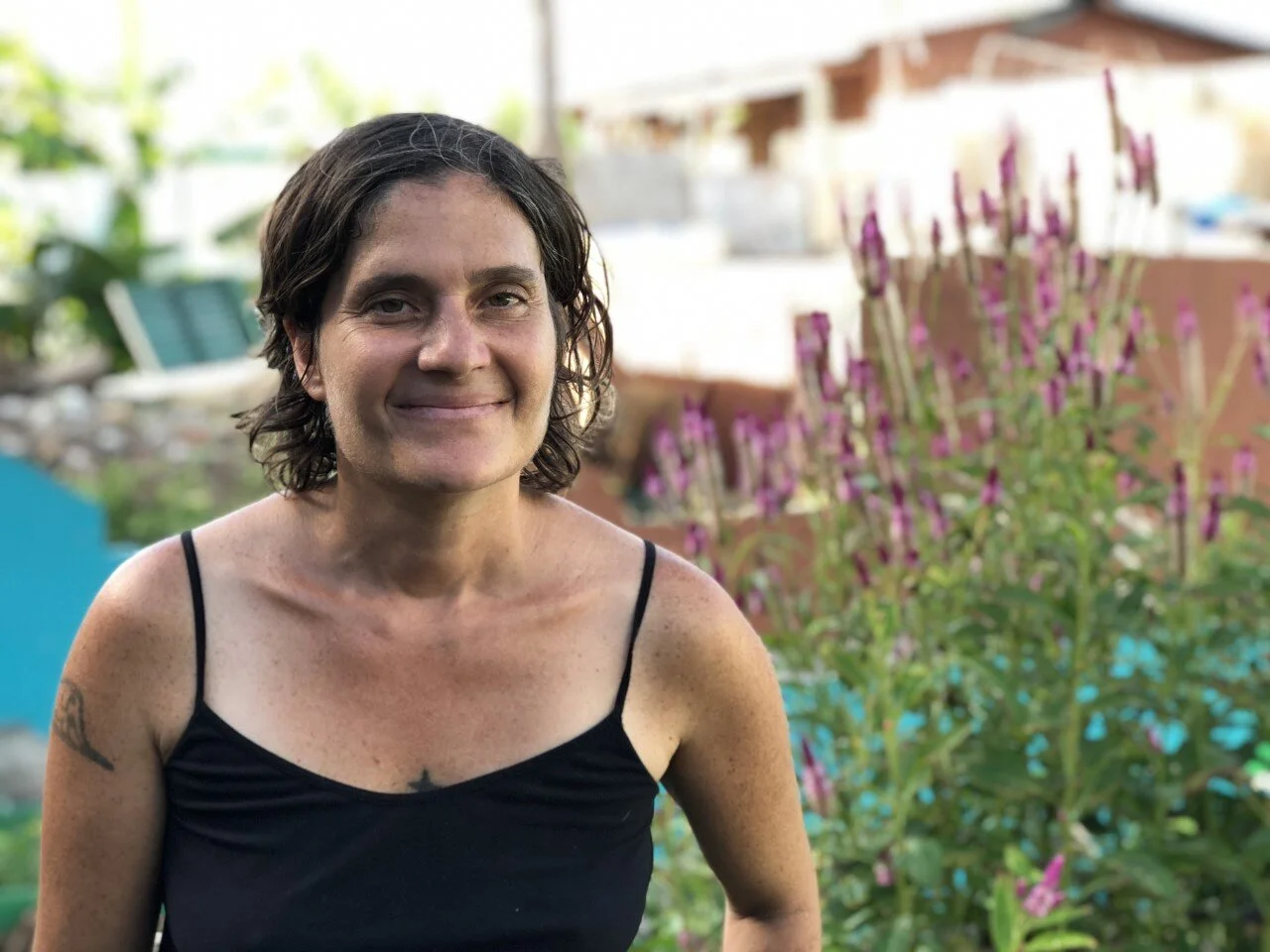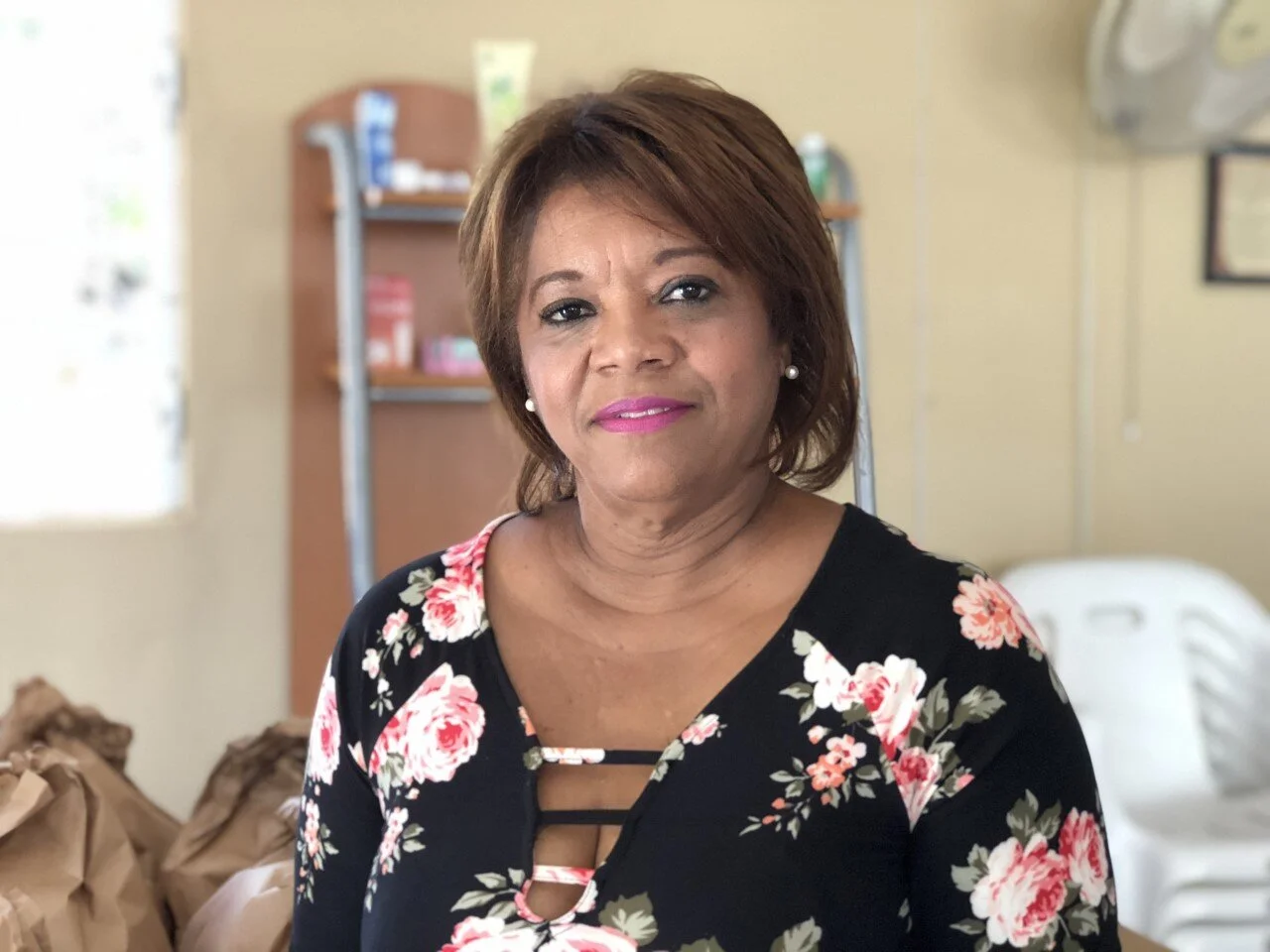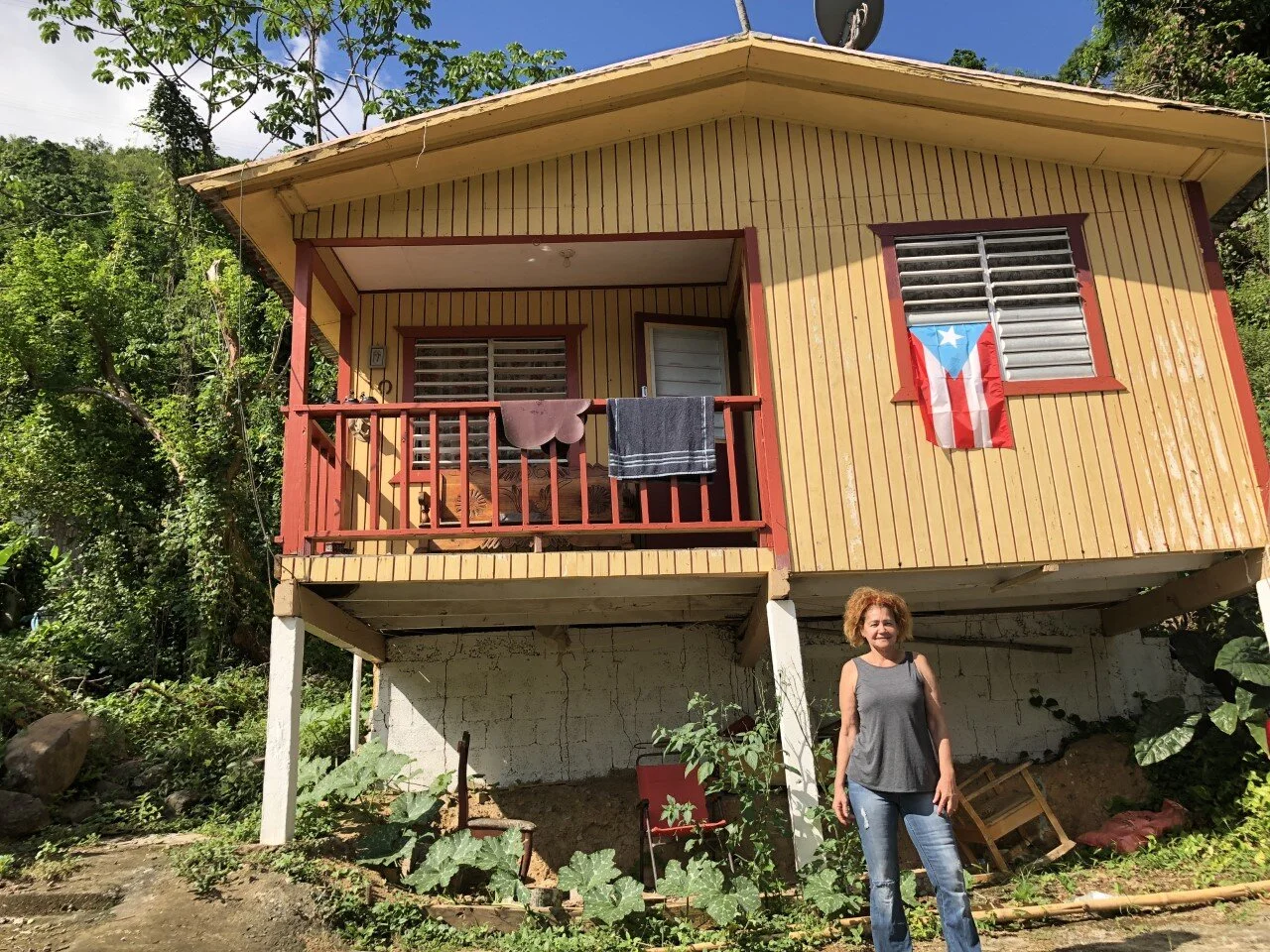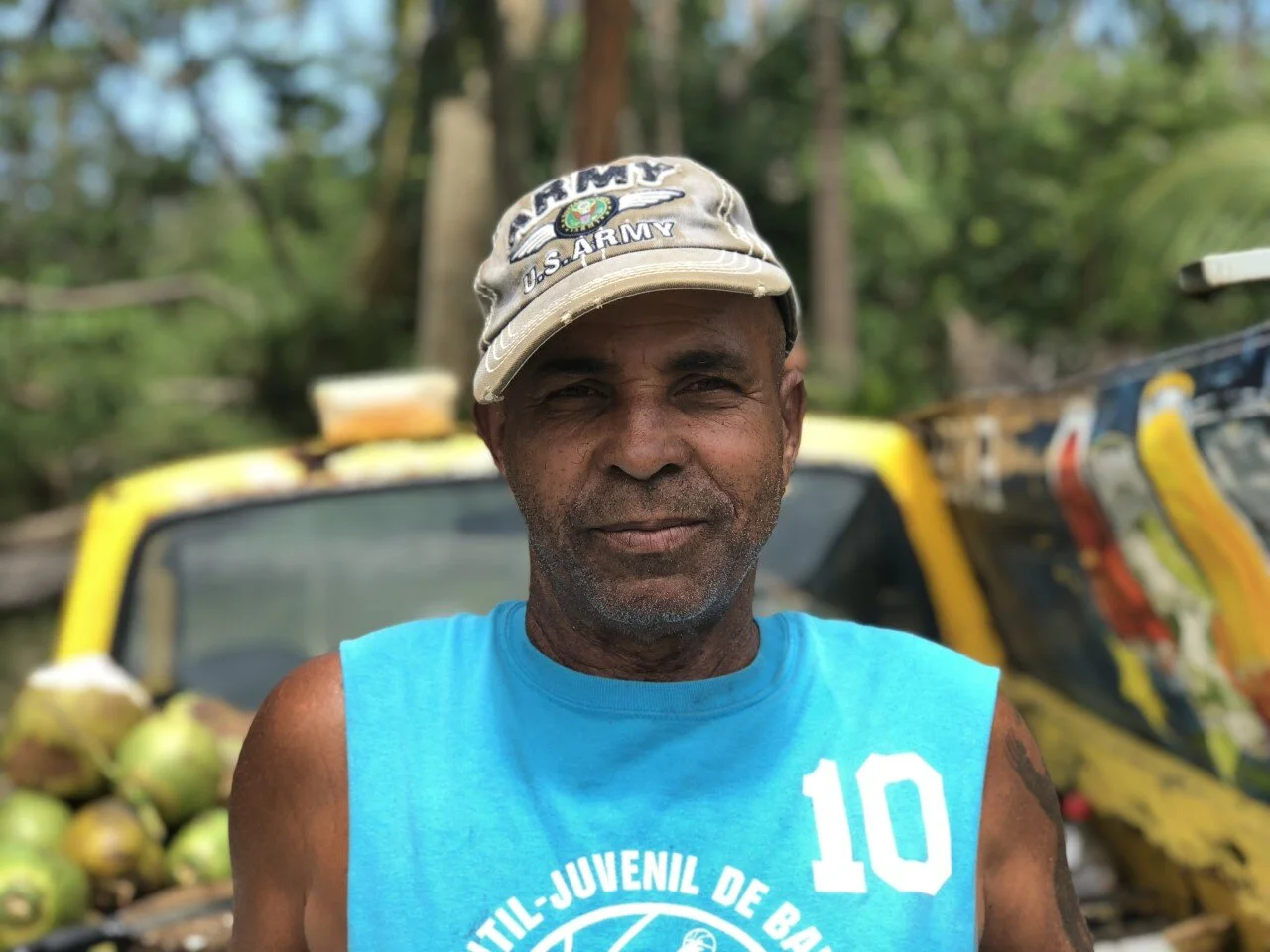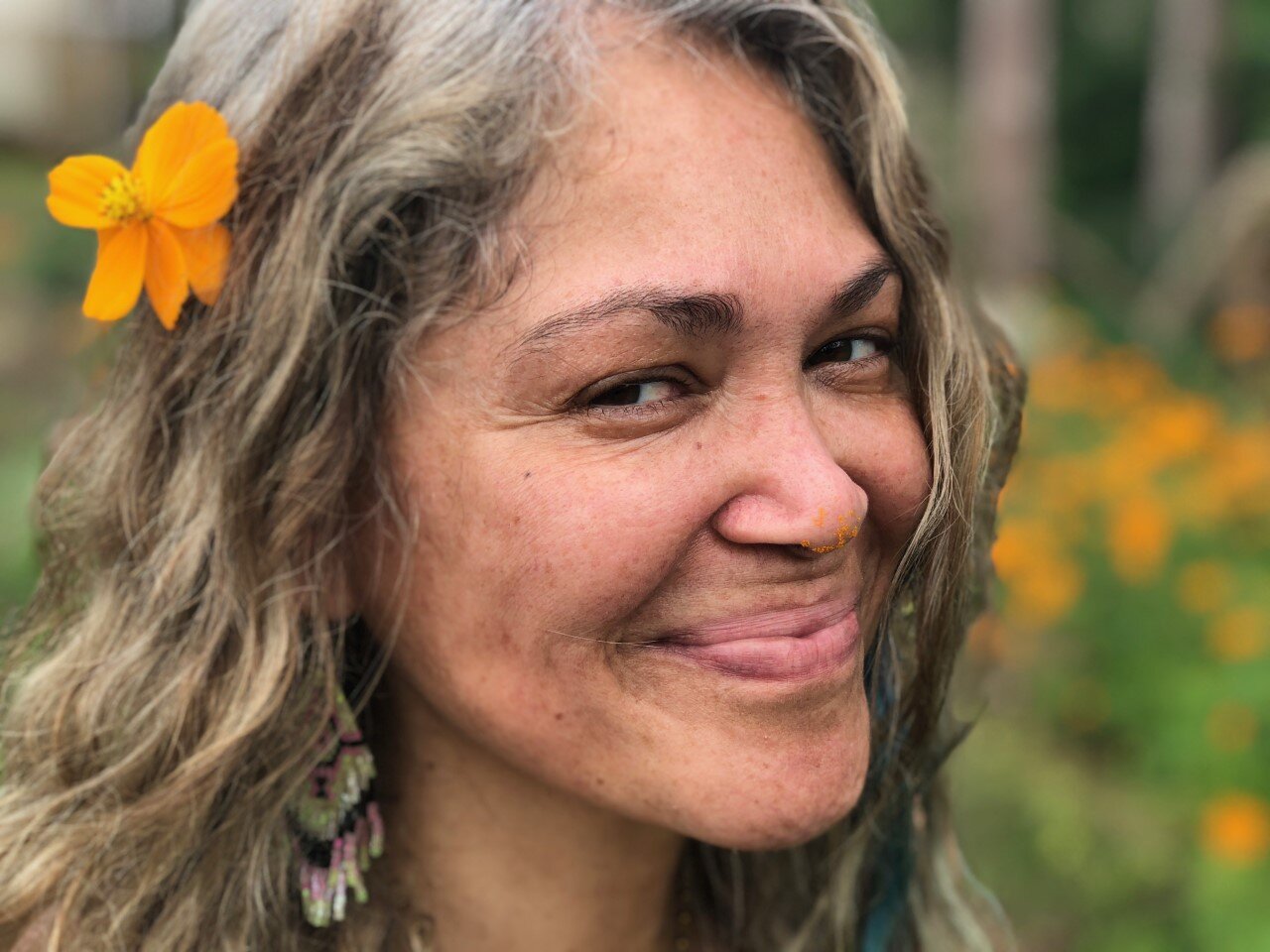
Holy & Water
Puerto Rico Climate Change Portrait Series
This is an on series of intimate stories featuring survivors of climate change disasters on the archipelago of Borikén. The project combines storytelling and seeding the land of my ancestors.
Holy & Water: Hurricane Maria Survivors Speak
Learning about the mounting food insecurity–one hundred percent of the farms were destroyed by the monster hurricane – I traveled with two million non-GMO seeds. After the storm millions were eating, if lucky, canned goods or dried food in military pouches. On an island that imported 80 percent of its food before Hurricane Maria, food was and is a fundamental concern. I raised money to buy non-GMO seeds from a small group of friends and carried them to the island of Borikén three months after the category five hurricane’s devastation. My aim was to help seed the land. My hope was listen to stories. My desire to help in anyway I could. I invited friend and television host, Rebecca Gitana Torres, to join me. It was an organic artistic collaboration, whoever had the camera on hand took the photograph or set up for the video interviews. We asked questions. Mostly, however, we listened. We cried. And we gave away two millions seeds.
This was a self-financed journey– a project that I wanted to produce because I wanted to see with my own eyes the devastation I was watching from hundreds of miles away. And not just see, and collect stories, but give. Seeds. Wild seeds.
We drove for two weeks from Condado to Luquillo and Fajardo, Vieques, Patillas, Maunabo, Yabucoa, Guayama, Guayanilla, Peñuelas, Ponce, Utuado, and La Perla. Armed with an iPhone 8, packets of the donated non-GMO seeds, and our compassionate hearts, we met some of the most graceful humans on the planet. In the backdrop of all this was the natural splendor of the island which was blossoming at a rapid pace and serving as an inspiration for people suffering the trauma of the storm and the aftershocks of government incompetence and corruption. Nearly five thousand people died as a result of government neglect. And more than 300,000 climate refugees of all ages left the island
People to people donations played a crucial role in saving lives days and months after the hurricane. Many of the people we met said that it was human to human care that helped saved them from starvation, and even death.
With no electricity and access to clean water and little to no food for months, people were eating canned goods or military packets. If they were lucky they fueled generators with diesel fuel which spewed toxins in the air elevating the number of asthma cases on an already burdened populace.
Finding affordable fresh vegetables then and now, continues to be a challenge for the citizens of the island so planting and harvesting at community and family scale makes a dramatic difference on the daily lives of many. The bulk of our seeds were donated to Mara Nieves, an urban permaculture farmer who runs a community garden in La Perla. With our initial donations she founded twenty ecological community gardens in schools where today, children and families harvest everything from beans to basil.
These are intimate portraits of survivors of one of the deadliest change disasters in modern times. These are some of the most graceful people I have ever met in my three decade career as a journalist. I hope you are as inspired by their resilience, grace, and heart as I was. We left wild seeds everywhere.
(I am still raising funds to purchase seeds for the next series of Holy & Water: Guayanilla: The People of the Earthquakes.)
Photos: Sandra Guzmán & Rebecca Gitana Torres
Elier Rodriguez, 9, Fourth Grader, Mala Pascua, Patillas
“It screamed, it howled, it barked, it hollered, it was like phantasms screaming and flying overhead.”
Elier was eight years old when Hurricane Maria ripped through his two-story cement house located less than 500 feet from the Atlantic Ocean. The coastline is his playground, his front yard, his everything. He said that when he grows up he wants to be the guardian of the sea.
“He cannot strop talking about the sounds of the storm,” Elier’s mother Carmen, “I think he has PTSD.” When we asked Elier to describe what he heard he recreated the sounds. “It screamed, it howled, it barked, it hollered, it was like phantasms screaming and flying overhead.”
At one point he remembers feeling that the house was moving from the 100 mile per hour winds. The fourth grader said he had a bad feeling that the house was going to be swallowed by the sea or the storm, or both. If the eye of the storm had come through Maunabo, the boy explained, referring to the town next to Patillas, the sea would have been inside the house. “It wouldn’t been really bad.”
As it turned out, the eye of the massive storm entered two towns over, in Yabucoa. In the middle of the night as gusts of wind and rain pounded the island, Elier recounts helping his dad empty buckets of water from the living room. His mother, pregnant with her third child, gave birth to a baby girl two days after the storm. She was one month early. The baby is a beauty and healthy.
For Elier’s 9th birthday, three weeks after the storm, he said he saved $60 dollars in cash from his grandparents, aunts, uncles, godparents, and family friends. He saved enough to buy himself a gold watch he’d been wanting. So what its faux gold? He wears the watch everywhere– even to sleep his mom says.
Beatriz Miranda Tapia, 76, Vieques
We found Beatriz emptying her deceased brother’s home on Calle Granate, a ten-minute drive from the port in the Isabel II neighborhood in the small island of Vieques. The two-bedroom cement structure was surrounded with fallen trees and debris. Hurricane Maria totaled the island of 9,300 residents and its only hospital.
Beatriz’ brother, Quique, died two months after Hurricane Maria. Renal failure. Most of the residents on the island are on some sort of dialysis, either have or know someone with diabetes or cancer. By the time medical help came in the way of a helicopter to transport him to the mainland (Puerto Rico), it was too late Beatriz explained, her brother was in a coma. He died two days later. When asked if he was killed by the hurricane Beatriz said, “not directly. He was killed because after the hurricane the island was a disaster and officials couldn’t get it together.”
It was Day 79 when we visited Vieques, located six miles off the coast of Puerto Rico. The once thriving tourist island had no electricity or access to clean water. The ferry was still not working properly coming and going whenever the captain felt like it.
All the wealthy people protected their mansions and left. Uprooted trees revealed more mansions than residents knew existed. It also revealed the dire poverty.
Inside the house there was mold everywhere. There was one photo of a group of men in uniform, none of whom Beatriz knew. The US Navy occupied Vieques and used it for its main training site for over than fifty years. The US Navy squeezed families into the middle of the island, robbing them of their precious coastlines. The US Navy stole their land and coasts and preceded to practice live bombing as children went to school, fishermen went to sea, women went to church. Every day for more than fifty years the US Navy live bombed. Sometimes the US Navy invited other countries such as France, to train in Vieques. Years of local protests and with the help from the rest of the main island and pressure from the Puerto Rican diaspora finally pushed out the Navy in 2003. Still, there are metals everywhere in the ocean surrounding the island, in the earth. And many people have cancer or are on some form of dialysis.
With machete in hand, Beatriz’ 9-year old grandson, Arnaldo Rivera Media, was cutting branches strewn all over the small patio. They were selling the house. Directing the cleanup was her husband, 78-year-old Mario Torres Concino.
Ruben Ramos, 71, Farmer, Utuado
To say that it’ been rough for the jibaros who live in the mountains of Puerto Rico after Hurricane Maria is an understatement. In fact, nine months after the storm, the people of the town of Utuado and surrounding municipalities still don’t have electricity. Ruben’s farm is still in critical condition. Like many of the small farmers in the region, he doesn’t have the equipment or staff to clear out the paths and clean up the littered land. Government, local, or federal has been slow to help.
Jibaros, as country people are called here, clocked Hurricane Maria’s winds at 205 miles per hour. During the most intense moment of the storm, Ruben remembers feeling that his two-story yellow wood-frame house perched on one of the many tall mountains along central part of the island called La Cordilera Central was going to be uprooted. It was not. When it was over, he says the municipality and farms were unrecognizable.
Many of the images of a devastated Puerto Rico post hurricane in the media were images of Utuado, a town whose original indigenous Taino name is Otoao, which means between mountains. As poet Martin Espada said during a reading Poet for Puerto Rico fundraiser at Poets House last November, for the first time the town of Utuado made it to the New Yorker magazine. Trees down. Bridges broken. Rivers overflowed. Life stock drowned. Residents were cut off from the rest of the island. Without food, access to clean water, and electrical power, many families in desperation, wrote SOS on the roofs of their homes and sidewalks, resembling desperate images of New Orleans residents post Hurricane Katrina. Residents had to fend for themselves in a way that the farmer says, they will never forget.
They don’t want a repeat of what happened weeks after the hurricane he says. Days after the hurricane friends, family, and strangers from the US, had organized donations of food, clothing, water, and other life saving medical supplies but national government officials and FEMA would not guarantee that the supplies would make it to the town of thirty thousand residents. Officials alleged there was no way to get to the mountains.
“We kept hearing that FEMA and the Governor’s people took all the donations that arrived and not send them to the intended destinations. No one knows what happened to supplies.” But residents of the region pressured local officials who pressured San Juan officials, and FEMA and protested until they were ensured life saving supplies. These donations Ruben says helped save lives.
Still, many were lives were lost according to Ruben, His neighbor committed suicide, and he heard that others in the community died because of lack of medical care and medicines.
Some people have lost hope its been so rough but many others have not. Ruben and his neighbors have rebuilt bridges by hand and with whatever supplies they could muster using their funds. They are pooling money and getting solar panels. He says that the experience of being abandoned by government has inspired the jibaros to consider where they get their energy. Now families are installing solar power.
Maria’s lessons have been profound but the most powerful one this farmer says has to do with the Puerto Rican Diaspora.
“I feel so much gratitude. Even though they live over there, or they were born elsewhere, their hearts are in Puerto Rico. That has been an unforgettable experience. It has been a beautiful experience for Puerto Ricans here to see our brothers and sisters over there so preoccupied for willing and us to help. If the Hurricane had a purpose, it’s for all Puerto Ricans and for the Diaspora, the ones who have immigrated looking for a better future for their kids and themselves and the children who were born over there, to see that they have never forgotten that this is their motherland, that their roots are here.
Ruben was also our driver and guardian during the reporting of this Holy & Water project. His help, knowledge of the island, and wisdom was incredibly helpful and continues to be a source of inspiration.
Zdenek Rodriguez, 27, Waiter,
Zdenek and his family
Hurricane Maria left him homeless and desperate to find shelter for his family. Three days after the storm, the 27-year-old father pitched a tent at a basketball court located in front of one the most storied and beautiful beaches on the island, the famed Balneario Monserrate in the seaside town of Luquillo. It was the only place the native of Rio Grande said he felt safe enough for his wife Claritza and five-year-old son, Yamil. And it was also within walking distance to his job at one of the kiosks located on Route 3 in Luquillo. A week later, another couple arrived with their tent, and within two weeks, more arrived. By December, three months after the storm, there were thirteen families, including a two-year-old girl, a five-year-old boy, two teenagers, and a grandmother all left homeless by the monster storm.
The popular beachside kioskos were not open for business, including the one he worked in. But Zdenek, left unemployed by the storm, wanted to be close by so as soon as the restaurant-bar opened, he could start working. Although the hurricane destroyed his material possessions, the waiter and bartender said the storm gave him what he deems a most beautiful gift–a new family. The group christened itself, Comunidad La Fe.
“We did not know each other before the storm, now everyone here feels like family.”
In fact, the bond Zdenek says he has with the homeless families is deeper than his own blood. He says they have rituals that most families with homes would dream about.
“We have coffee with each other in the mornings, dinner as a group in the evenings. We take turns preparing the meals. At 9 p.m. we read the bible together, and at 9:30 p.m., each night, a trumpet player who plays with well-known bands around the island, plays a song. Two churches have come to offer servicios and pray with us.”
The group created a makeshift kitchen, bought a portable toilet, and plan to celebrate Christmas together. When we visited them, the Holidays were three weeks away and someone donated a small plastic Christmas tree.
It gets rough when it rains he says. They have to pack their tents, their plastic Christmas tree, and place all their belongings, which is not much, on the bleachers, and wait until the rains stops. A family of pigeons, which used the court as their home and also shat all over it, still comes to do their business.
According to Zdenek, who says he is shy and was pushed to become the official spokesperson of the group; the group feels like they don’t have much choice but to stay living in tents. Leaving the island to a hotel somewhere in the US is not an option for them.
Hiding in plain sight along the main road on the northern coast of the island between San Juan and Fajardo was a group of homeless hurricane survivors living under a basketball court and no one in any official capacity– press, FEMA, local, national or Federal government officials– went to check in on them for months he says. On day fifty-four, a reporter from Telemundo arrived. Three days after the story aired, the mayor of the town of Luquillo, a walking distance from the homeless tents, finally showed up.
They were offered shelter–hotels in the US, or some, an apartment in a housing project– but they all relented. By then, they were a family and they wanted to remain close to home and each other.
“If you are going to pay a hotel bill while we get back on our feet, why not pay rent on one of the many abandoned houses on the island?” They planned to stay there until they had saved enough to rebuild.
A few weeks into their stay a woman arrived and seeing that they had water bottles, bags of rice, and canned foods– beans, sauce, meats–she offered them all she had– an inheritance.
“A stranger came in and dropped off three boxes of costume jewelry. She told us it was her only inheritance, and it was worth $150,000. She told us to sell it so that we could get on our feet again. She said wanted to remain anonymous. She said it was all she had and she wanted us to have it. Hurricane Maria brought out a lot of beauty in many people.”
Turin, 69, Farmer, Jaguas, Peñuelas
The sixty-nine year old farmer sprinted up the steep mountain like a teenager, laughing, and after digging into the earth for yams. He turned his tee shirt into a sack for the harvest showing a toned six-pack that didn’t arrive from workouts at a gym, rather, from years of physical labor in farms around the southern coast of the island.
Turin took us to harvest ñame, the nutritious tuber that everyone in the tight neighborhood of La Jagua ate after the storm. The father of three worked in the petrochemical company built on one of the most precious coastlines in the Caribbean robbing the citizens of Peñuelas access to their beach. The men who worked at the plant in the 70’s say that under the earth where the plant sits, abandoned and leeching toxins into the soil, there are many dead bodies. There are stories of men falling into smoldering cauldrons, gruesome accidents, and fires that were never reported. For thirty years the plant has been an eye sore, shut down and abandoned by the US-based corporation.
Residents here feel duped and have been waiting for clean up for four decades. It should be on the Superfund Priorities List. It is not. To add insult to an injured population, San Juan government officials continue to send most of the island’s garbage– toxins that were outlawed in the Dominican Republic because they caused cancer and birth defects– to a Peñuelas landfill. The battle to stop toxic ashes from being dumped just a few feet away from the plant rages on.
So when this humble farmer talks about surviving Hurricane Maria, he says Puerto Ricans have been surviving worse: imperialism.
Working at various construction jobs, going off to the Vietnam War, and tending to other farms, Turin worked day and night and scraped close to $20,000 to buy a small parcel of fertile land once owned by his boss. Now he spends his days tending to his beloved family of trees and plants–mango, orange, lime, cereza, a tropical cherry, guava, coffee, guanabana, wild beans, gandules, banana and plantain among others.
“On this land is where I feel happiest, working with the earth is where I feel at home and at peace. I am enchanted by this earth.”
He weathered the hurricane in a small cement house he owns at the edge of town. And hours after the hurricane’s winds stopped, he walked several miles up the mountain to see how his beloved plants and trees fared.
The hurricane ripped through his small farm which sits on a steep slope on one of the many mountains in the town known as “la tierra de los bravos.”
He lost fifteen percent of the trees, and all of them left where the storm dropped them turned into food for the earth and homes to other creatures. But he says when he saw the grandmother avocado tree– his favorite–every farmer has a favorite tree–ripped from the earth, her massive roots exposed, he cried.
Turin took us to plant a baby avocado tree still mourning the loss of the one the storm killed. “I may not be around to see this tree bear fruit but I know that it will give birth to the best avocados in the world and someone will enjoy them.”
On day 85 of the storm, when we spoke to him, he still had no electricity in his humble house.(1949-2019)
Gladys Nazario, 61, Ethnobotanist, Professor, Utuado
Gladys became an ethno botanist because of the mountain. She moved to Utuado, a municipality located in the central part of the island in the Cordillera Central, when she was 20 years old from the capital city where she was born and raised. She said the elders and nature took care of teaching her about plants. Back then; the town’s roads were lined with flowers called miramelindas.
It was a magical place. In fact, the First Nation inhabitants of the island considered the region sacred and held many spiritual ceremonies there. Just down the road from where she lives is Caguana Ceremonial site with ball courts that date back to 1200 to 1500 A.D.
She went to the University of Puerto Rico to study botany and has spent thirty years teaching it to new generations. Her knowledge of indigenous plants is encyclopedic. Her passion for nature is contagious. Many of her former students are part of the agrarian revolution-taking place on the island. We met one, Eliza, who is part of the story and who runs a farm in Vieques. She talked about an inspiring teacher and to our joy, it was Gladys.
Gladys has returned to the mountain full time after three decades of teaching botany and ethno botany on the Rio Piedras campus. The two-bedroom cabin she shares with her husband Papo was intact after Hurricane Maria. But the town where it sits was not. Utuado was torn apart by the storm. Residents were cut off from the rest of the island when all its bridges broke and rivers overflowed. Without food, access to water and electrical power, many families in desperation, wrote SOS on the roofs of their homes and sidewalks.
When the storm made landfall, Gladys was in Rio Piedras where she and her husband of forty years have an apartment. They did not think that their country cabin would withstand the strong winds since it is perched on top of a mountain. To her relief, all the trees that surround the house were still standing– leafless, bare, burnt– but standing. On day 90 when we met, the trees looked like they been had bad haircuts. She now can see past them for the first time in forty decades and into several of the sacred lakes in the valley below.
“The hurricane was terrible, just devastating, the trees disappeared. But it was also extremely magical too. The way nature behaved. The way trees behaved. There are people suffering, without food and water. But this was the best thing that happened–it was a necessary revolution. The hurricane was a necessary evil. People were too lost in technology, in the phone world. And now everything has been exposed. People are trying to do things together–that was not happening before the storm.
Nature is responding so well. And people are going back to basics. People are talking more, getting together, and doing things together. They are realizing how bad things are here. Politics is really, really bad, lots of corruption in government and everywhere.
We needed something like this to become aware of all the things that were happening and to stop it. I have hope in the students and in the youth of Puerto Rico– they are reacting in a marvelous way.”
We needed to get out of our comfort zones just to realize that we have around us. And to realize that we can do it by ourselves. We didn’t trust ourselves before. We realize all we have is each other.”
Provi Davila Torres, 63, Caretaker, Yabucoa
Hurricane Maria entered Puerto Rico through the town of Yabucoa, which is located two hours east of San Juan. But unlike the capital city which was up and running and welcoming tourists quickly, nine months after the storm, many residents say it’s as if the hurricane never left . While the physical remnants of the storm, uprooted trees, cracked roads and bridges, light poles leaning in the direction of the winds are a testimony of the devastation, the people of this municipality are moving forward. The faith of people here is powerful.
We conducted the interview with Provi in front of a holy spot, the base of La Piedra Blanca, a massive boulder located on top of the highest peak that looks over the verdant valley. The mother of two lives in a three bedroom cement home that is nestled on the side of the mountain. Her home is tucked underneath the massive rock that that soars five stories high.
“I think this rock is our guardian. In the 1960s the only road to go through town was by the rock. In the 1970’s, another road was built and this place was forgotten. I call it “The Silent Rock.”
The eye of Hurricane Maria entered through the municipality tearing up trees, homes, every single light pole, cars, boats, inundating all the farms, and killing wildlife. But La Piedra Blanca, which faces the ocean, withstood powerful winds and tornadoes that came roaring through. From far away the gray polished boulder looks like a giant pyramid. It is reminiscent of the Poynesian Easter Island beachfront statues. The storm cleared trees that covered the boulder exposing a glorious rock and what some locals believe is a giant indigenous zemi, a spiritual sculpture that houses an ancestral spirit.
She said that at the beginning of last year, foreign rock climbers came and desecrated La Piedra Blanca. They made a video and posted it on Facebook.
“They left nails in the rock. Never in my life and in the life of the rock nobody has done that. It was very sad. I feel it was very disrespectful. I am afraid others will come. I said the rock is my guardian, maybe we guard each other.”
Provi explained that weeks before Hurricane Maria arrived she saw something by La Piedra Blanca.
“I saw a row of men and women surrounding the rock a few months before the hurricane. They were holding hands, looking in the direction of the sea where the hurricane came. I tried taking a photo but its blurry. I couldn’t believe my eyes. About a year and a half before, I dreamt about a bad hurricane that was coming toward Puerto Rico but I woke up before I learned when. And then nothing happened so when the hurricane was announced, I felt this was the one. I put a message to my brothers and sisters and told them to watch out.”
Provi was unable to afford storm shutters for all her windows and doors so did what she does best, prayed.
“I prayed to God and to Our Lady, I am Catholic. I looked for all my religious metals and virgin and the Heart of Jesus I put them on the windows, doors, and my cars. “Take care of us and of our things,” I prayed, “We don’t have much.”
She said she closed all the windows and doors and with her daughter and son sat in the living room by her altar, and prayed.
“When “the thing” started to blow, a sound so strong, hours and hours passed, like a drill, when you are making a hole in the wall. The sounds of the wind–we heard voices, my son felt the earth moving, we felt tornadoes, it was like a bomb, like many people were throwing bombs, and bombs, and bombs. It was very impressive. It was here for more than 20 hours — from 6 am on Sept 20th and at 6 am on September 21st we were still feeling those winds.
Hurricane Maria stayed in Puerto Rico for 24 hours.
“We could hear the winds destroying the trees, we heard things crashing, We were aware that there was no water coming in the house. And we knew that at any time the doors and windows would fly off.”
When she stepped out 7 am the next day, feeling safe that the winds were lowering their speed, she opened the door and saw the once lush green valley gone.
Some people described the day after the storm as total devastation. Provi saw something else.
“We were purified. All mother nature, all the trees–there was nothing, nothing, nothing. I said thank you God, you saved our lives. Around my house we have a big forest and that day there was nothing.”
When asked what one word she would describe Hurricane Maria she said: teacher.
And the lessons she said are not just for Puerto Ricans but for the world.
“Our God is sad because we have forgotten about him. We are just surviving. We have very busy lives. We don’t stop to talk with him to do what he wants us to do–to have a simple life, to spend more time with our families, with our children.
There is so much automation, so much technology making everything easy, and we want more and more. We are not pleased with a cell phone, we need the latest model. We have to be more humble, take time to look at nature, to appreciate what we have on our planet, a planet we have devastated. We have to start taking care of our plants, talk with our plants, say thank you for the food they give us, and teach our children and grandchildren. I see fast food restaurants full. People don’t make dinner at home anymore.
I don’t think we can survive many years like this. Human beings feel like they don’t need God. Many people have created many things now they they think that they are the gods.”
Now, with no electricity at night we look at the stars and the moon and we are talking again about the lost tales. We play dominoes. We are like it was in the beginning.”
*Provi Davila Torres is Rebecca Gitana Torres’s cousin, They did not know each other. Like many families divided by immigration, the storm reunited them. She was not supposed to be part of the story, but Provi’s testimony was too powerful to keep it just with us.
Mara Nieves, 41, Urban Permaculture Farmer, La Perla
The community garden in La Perla, one of the most iconic neighborhoods on the island made even more famous by the song Despacito, was toppled when the roof of a nearby house landed on the plants. Hundreds of plants fought for their lives. Mara, whose knowledge and relationship to indigenous plants and the natural world is a joy to experience, had been running the garden five months before the storm. The garden with medicinal and edible plants was beautiful, she said.
Lush, green, vibrant. Kids would pick mint leaves on their way to school and chew on them like candy, ladies would harvest recao for their sofrito, and everyone picked at the oregano brujo leaves to help heal bruises and cuts. Then Hurricane Maria arrived and everything was just charred.
“I noticed that initially there was a lot of devastation. It was very impressive to see the impact of strong winds on plants, but the same force and energy of the earth also created an incredible amount of regrowth where everything started to bloom. You’d see trees fallen over and blooming all over the place. Nature does know what its doing.”
It was not just the garden that was ruined, most of the homes in La Perla also suffered devastating damages. The community is still hobbling. The mom of a pre-teen son says that she was one of the few, lucky ones. Her home did not suffer any damages except water, which she mopped up and kept in buckets and used to flush the toilet.
While the plants recuperated in the garden, the tubers came through for the community of 300 residents days following the storm.
“We harvested malanga, tarot, and some of the the ladies had cassava, sweet potato. We made a sancocho. And then we harvested the basil, which suffered greatly but we were able to make pesto. We started a community kitchen. It’s how we survived.
Surviving Hurricane Maria empowered the urban permaculture farmer.
“It felt like we were on our own, off the grid, finding our own selves with our own help. You get a sense of the power that the community has in situations like that and how we can come together.”
A few weeks after Maria a salt storm killed more of the plants.
We arrived three months after the hurricane and the garden was showing signs of rejuvenation. Boxes were constructed and seedlings were growing. There were happy plants: ahi dulce for sofrito, arnica, lettuce greens, yanten, a medicinal plant for the flu and immunity booster, turmeric, flor escondida, good for breaking-up kidney stones, amaranth, moringa, basil, tomatoes, beans and many more.
“I am learning a lot from my neighbor Sonia who lives next to me. She is the curandera of the community. A lot of people go to her for remedies. That is our next stage, to rebuild this into a huge medicinal garden.”
Mara became the seed point person after the storm and non GMO seeds arrived from all over the US.
“We are experimenting to see if we can get greens growing faster in smaller baskets. We are helping to build farms for disasters. We are committed to creating community gardens in any community that wants them. We are especially interested in medicinal gardens too, a lot of people want to learn what plants help the body, especially kids.”
With string budgets they have done so much. She conducts workshops in schools and in the community, has created, with a small group of volunteers, nearly one hundred eco community gardens where people have access to fresh healthy food.
Now she says they are desperate for space. They are looking for a donor who does not use their land so that they can farm, and plant the seeds that they have received. They want to start a seed bank which the island does not have.
“We have to keep the seeds going. We’d love to have a land to provide a living space for seeds and plants so that we can give to other organizations and to people. We want to help design farms for disasters. So much work to do, and we are ready for it.”
*Rebecca and I dropped off most of the non-GMO seeds were carried to the island to Mara. Our donations help found twenty gardens in schools so that kids and families can harvest fresh food.
Elba Oquendo Pizarro, 61, Healthcare Activist, Vieques
Elba began telling the story of the storm that ravaged the tiny island of Vieques with one word: “Wow!”
When we met seventy-nine days had passed since Hurricane Maria made landfall on the storied island with gorgeous beaches, two bioluminescent bays and a history of abuse in the hands of the US. Everything she and her community experienced was still raw and painful to recount. But the health care activist said this was the kind of story too important not to share with the world.
The storm pulled out the air conditioners from her home and inundated the entire house ruining all her furniture and clothing. She was not there to see it happen having decided to weather the hurricane with a friend. When she returned the next day to her house the destruction overwhelmed her with sadness. She said it was a total disaster. She cried not just for her loss, but for the entire island.
With no electricity and cell phone service, no way to communicate with the outside world, and no mode of transport to leave the tiny island located island six miles from the coast of Puerto Rico, the days and weeks following the storm were a nightmare she said. No food, no ferry service, no planes, and no way to communicate with the world. Those were really dark and scary days according to Elba.
All the streets were flooded. Mounds of sand were left when the water receded. Uprooted trees and remnants of whatever the hurricane’s winds brought were strewn everywhere. Most of her neighbors lost everything, cars, homes, small businesses. Some are living with friends but mostly they are all leaving to Florida, Connecticut , and other states.
In the middle of sharing the story, Elba, the Executive Director of Vieques En Rescate, a non profit community organization that helps residents with cancer, cried and cried. For Elba there has been no time to mourn. She cries in spurts she says. She feels a huge urgency to care for cancer patients that her organization helps and who are in more need than she is–the 30-year old mother of two babies with breast cancer and the more than fifty other clients that needed desperate chemo treatment.
An angel donor gave the foundation a working phone, the mayor lent them a temporary car for a few weeks and they were able to get emergency space in the ferry to get some desperate clients medical treatment on the big island during the first month of the storm.
The only hospital on the island was totaled and in any event, they don’t provide chemo services.
Vieques is a cautionary tale when colonialism, capitalism, and climate change collide.
Five years ago she and a group of women started Vieques En Rescate after years of being played by the American Cancer Society. She said they were part of the local chapter of the American Cancer Society. Every year the big guns arrived to Vieques and hosted fabulous fundraisers. Then, they took the funds they raised to the US.
When Vieques cancer patients needed to access the funds, it was very difficult if at all. Sick of being used, a group decided to sever ties and start a local association and do their own fundraisers. The organization provides ancillary services to the men and mostl women who are undergoing chemo treatment. It also offers nutritional supplements, sometimes food, help with medicines. But mostly she says, “we give them love.”
These are the three women who power up Vieques En Rescate:
Cancer is a huge problem on the island that the US Navy occupied and used as a bombing range and testing ground for over sixty years ending in 2003. Though Elba doesn’t have the hard data that links the decades of live bombing and munition testing by the US Navy to the isle’s high cancer rates, she certainly has the people who are sick with breast and other cancers, and with pulmonary diseases and asthma, and diabetes. The humans she cares for she says are evidence enough for a link.
In 1941, the US Navy squeezed families into the middle of the island, robbing them of their precious coastlines, and then proceeded to practice live bombing as children went to school, fishermen went to sea, women went to church. Sometimes the US Navy invited other countries such as France, to live bomb and train in Vieques. Years of local protests and with the help from the main island and pressure from the Puerto Rican Diaspora and their allies finally pushed out the Navy in 2003. Then the W and other high end hotels moved in but didn’t really employ the mostly black residents. Viequenses can’t catch a break.
There are dangerous remnants of toxic chemicals in the environment–large chunks of the island and surrounding waters are an EPA Superfund Site, and listed on the National Priority Cleanup List. Residents are waiting for the clean up to begin and also, reparations for their suffering.
The island is hobbled by inconsistent ferry service which is why residents say they feel like prisoners in their own home.
In fact, when we visited the island we got a taste of the chaos. The ferry was scheduled to depart at 4:30 pm but left at 3 pm with a few passengers who happened to be there. When asked port officials said the captain felt like leaving. We left at 9:30 pm after being attacked by huge mosquitoes. After the storms left came the insect infestation and we had donated a dozen bottles of natural bug spray to islanders thinking we would be back to my home on the mainland.
“We are prisoners on this island. We have no other mode of transport. A six minute plane to Ceia is $45 but locals can’t afford that. We are at the mercy of the local Port Authority. There is no set schedule. There is no respect. We feel forgotten and its not just now. All the administrations of the mainland have had Vieques as an afterthought, if that. They don’t know or care about our necessities.”
“I heard that there is a group of women from Loiza who are planning a class action lawsuit for human rights violations. We want to join them. Our basic human rights are being abused and this has got to stop.”
Wanda I. Rodriguez Gonzalez, 57, Farmer, Barrio Jagua, Peñuelas
She saw trees and houses flying. Her neighbor’s house ended up in her yard. Her other neighbor’s washer machine too. But that was not the worst the mother of five witnessed. When she saw the mountains of her beloved town the morning after Hurricane Maria pummeled through the island, Wanda recalls doing two things: falling into prayer and crying.
The once lush green landscape of mango, coffee, guanabana, avocado, cherry, guava, and other fruit trees was leafless and burnt to a dark crispy brown. Then days after the storm she said it rained for sixty-two days. Rivers overflowed to the point that neighbors made human chains to cross the small bridge to their homes in El Sector Maldonado.
Then something magical started happening–felled trees began sprouting and there were pumpkin flowers and blooms everywhere. She went harvesting for ñame, a tuber that grows inside the earth, and shared the harvests with everyone in the community where she lives in a humble wood and zinc roof home. The area still doesn’t have electricity nine months after the hurricane. She spends her days replanting and harvesting–the hurricane left a large bounty.
Born in Ponce, raised in New Jersey, the mother of five returned to the island of her birth three years ago to farm. Today she is part of a group building a community garden and organizing for solar panels. We visited on Day 85, there was no electricity or running water.
“It’s a lot of work, we carry buckets of water, I buy two bags of ice everyday for my perishables. Ice prices are up. I saw young adults, teens, and kids cutting trees, washing clothes int the river, riding bikes–doing things that I used to do as a child. They can’t use cell phones so they are talking to each other. Adults having coffee and crackers on their balconies, with candles and under the stars. This hurricane has taught me about the meaning of community.”
“People here are are still suffering.”
*Wanda Iveliise is my oldest sister. I traveled to the land of my paternal ancestors to check in on her and other relatives. I didn’t plan to include her in the series but after she shared her stories, how could I not?
Tuntun, 56, Coconut Vendor, Playa Fortuna
Seven days a week you can catch Tuntun selling fresh coconut water on the shoulder of La Ruta 3 at a makeshift stand under three almond trees. You can’t miss him–his electric yellow pick up truck is parked by a stand that looks like a pop-up barbershop–a domino table, four chairs, a couch, and a white camping tent to protect him and his guests from the vicious midday tropical sun. Hurricane Maria destroyed most of the stand which is West Bound toward San Juan. Three months after the hurricane he is slowly rebuilding.
Tuntun was born and raised in Playa Fortuna, a coastal parcela in the town of Luquillo nestled between la Ruta 3 and the Atlantic Ocean. He spent a decade working in factories in Brooklyn, New York but missed the island and his family and returned three decades ago. He was a construction worker during his youth and helped build many of the skyscrapers that dot the town. His home is a two floor mix of cement and wood and is located 600 feet from one of the most gorgeous beaches on the island. It was too dangerous to stay so close to the ocean so he weathered the hurricane inland with relatives– he took his 85-year-old mother, 55-year old sister, a 29-year old son, and joined several nieces, nephews, aunts, and uncles.
Tutun got his nickname from his fierce conga flow, he says. He’s been playing since he before he learned to walk. He’s made a living selling coconut water for more than a decade. Before the storm business was booming. Puerto Ricans love coconut–candy, oil, and water–they use it to cook, fresh out the shell, and for skin and hair. They drink the oil for gut immune protection. Tuntun and his family know how to work coconut in all the ways imaginable.
Customers come from all over the island because Tuntun gets the best cocos available. If you like your water sweet, he knows which one to open. If you like your flesh soft, he knows that too, if you prefer harder flesh, well he picks just the right one from the hundreds of coconuts chilling in ice water. First time customers get an info sheet on the many nutritional value of coconuts. He says coconuts are the God sent.
For those reasons Tuntun is known as “The Coconut Whisperer.”
Since accidentally cutting his leg with a machete and falling 50 feet from a palm tree he stopped harvesting coconuts which is why he has a crew of young harvesters. And while weeks after the storm there were coconuts galore, now they are tough to find.
“Nature,” he says, “needs time to rebound.” (1962-2021)

